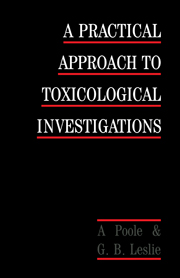Book contents
- Frontmatter
- Contents
- Foreword
- Preface
- List of abbreviations
- 1 Introduction
- 2 Regulatory requirements
- 3 Animals: sources, selection, husbandry
- 4 Standard studies in animals
- 5 Measurements and observations made in living animals
- 6 Terminal studies
- 7 Specialised routes of exposure
- 8 Reproductive toxicology
- 9 Genotoxicity
- Appendix 1 Toxicology data requirements for clinical trial approval and registration of new drugs
- Appendix 2 Countries and addresses of regulatory agencies
- Index
4 - Standard studies in animals
Published online by Cambridge University Press: 04 August 2010
- Frontmatter
- Contents
- Foreword
- Preface
- List of abbreviations
- 1 Introduction
- 2 Regulatory requirements
- 3 Animals: sources, selection, husbandry
- 4 Standard studies in animals
- 5 Measurements and observations made in living animals
- 6 Terminal studies
- 7 Specialised routes of exposure
- 8 Reproductive toxicology
- 9 Genotoxicity
- Appendix 1 Toxicology data requirements for clinical trial approval and registration of new drugs
- Appendix 2 Countries and addresses of regulatory agencies
- Index
Summary
In the process of developing a new drug, a series of animal toxicology tests of increasing duration are conducted. It might appear to make good scientific sense to run the studies of increasing duration sequentially so as to utilise the findings of a shorter study before designing a subsequent longer study. However, since patent protection of a drug is of limited duration (15–20 years) it is commercially important to exploit as much of the patent protected period as possible. Since, with many drugs, oncogenicity studies lasting two years or more will be necessary before marketing can begin, some telescoping of the sequence of toxicity tests is usually considered desirable. A calculation must therefore be made balancing the cost of studies against the likelihood of a successful commercial drug development.
GENERAL PRINCIPLES
Before describing the methods used in standard animal studies it may be useful at this point to discuss some general issues associated with toxicity studies, e.g. selection of species, group size, dose selection (more pertinent to subchronic and chronic studies) and route of administration.
Species selection
The choice of species for use in toxicological studies is a compromise between what is required or desired, and what is practical. Naturally, when performing any toxicity study it would be ideal to use a species with the same metabolism, pharmacokinetics and target organ susceptibility as man. It has been argued that regulators should pay more attention to pharmacokinetics and mechanisms of toxicity rather than relying on a regulatory checklist (Clarke et al. 1985).
- Type
- Chapter
- Information
- A Practical Approach to Toxicological Investigations , pp. 44 - 63Publisher: Cambridge University PressPrint publication year: 1989
- 1
- Cited by



